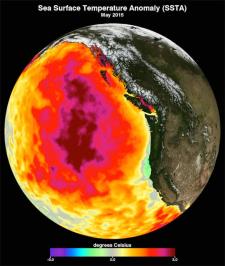 In the 1958 sci-fi/horror film, the Blob is a gooey mass from outer space which eventually grows the size of a small building while devouring everyone it encounters. The Blob cannot stand cold and is finally stopped by being airlifted to the Arctic. (The movie is notable primarily as Steve McQueen’s debut in a leading role.)
In the 1958 sci-fi/horror film, the Blob is a gooey mass from outer space which eventually grows the size of a small building while devouring everyone it encounters. The Blob cannot stand cold and is finally stopped by being airlifted to the Arctic. (The movie is notable primarily as Steve McQueen’s debut in a leading role.)
There is now a very real monster in the northern Pacific also referred to as the Blob. It is a mass of unusually ocean hot water that is having a disastrous impact on sea life. Codfish have been particularly hard hit. Because of historically low numbers of Pacific cod, the federal cod fishery in the Gulf of Alaska is closing for the 2020 season. This is the first time this fishery has been closed due to low fish stock.
The US Parks Department notes: No, [the Blob] didn’t come from outer space. It was detected in October 2013, a strong and long-lasting high-pressure ridge in the Pacific Ocean created a mass of warmer-than-normal water. This mass of water was between 4 and 10 degrees F above average (depending on the location and date) and stretched over 1,000 miles wide between the North American and Asian continents and was up to 300 feet deep…
The Blob resulted in the largest die-off on record of the seabird, the common murre, also known as the common guillemot. It also severely impacted salmon and cod such that the US Commerce Department declared Gulf of Alaska Pacific cod and sockeye salmon in Chignik as fisheries disasters for the 2018 season. Whales, sea lions, otters, and walruses were also affected.
After water temperatures appeared to be returning to normal ranges in 2017, record low ice levels were recorded in 2018. It now appears that the Blob has returned. In the short term, the cod fisheries in the Gulf of Alaska have been effectively shut down. In the longer term, the Blob may be the new normal in rising seawater temperatures.
The Blob could also have a major impact on weather in the Lower 48. As reported by the Washington Post:
Although the blob is focused over the Northeast Pacific and the Gulf of Alaska, it has played a substantial role in the development of extreme weather patterns over the Lower 48 when it has formed in the past. Generally, it has been linked to abnormally warm and dry conditions in the West, and cold and stormy conditions in the East.
When the blob is in place, the jet stream, which both divides warm and cold air and acts as super highway for storms, tends to veer north over the top of the blob. This results in a big ridge of high pressure forming over western North America, which brings mild weather and blocks storms.
The blob’s presence was linked to the persistence and intensity of the drought in California from 2013 to 2015. It also ″was blamed for contributing to 2015 being the hottest year on record in Seattle,” according to Scott Sistek, a meteorologist with KOMO in Seattle.

LOL…’ water temperatures’?? talk about not seeing the forest for the trees…will the real blob please stand up:
avaazdo.s3.amazonaws.com/865eeb3c96710bef1bc2427b72e45aa0.png
rense.com/1.imagesH/fukudeathsplash.jpg
doowansnewsandevents.files.wordpress.com/2013/04/radiation-map.png
globalresearch.ca/28-signs-that-the-west-coast-is-being-absolutely-fried-with-nuclear-radiation-from-fukushima/5355280
dd,
I cut the bulk of your comment but left the links you provided. (Leaving any part of the comment may have been a mistake on my part.)
The Fukushima conspiracy nonsense is a waste of time and I see no reason to give it more of a platform. Amusing how if “West Coast Is Being Absolutely Fried with Nuclear Radiation from Fukushima” as your garbage link suggests that no one else has noticed it in the last 13 or so years expect for your crazy conspiracy buffs at Michel Chossudovsky’s rag Global Research.
Looked at first link. Agreed with Rick. Wont even bother with other links.